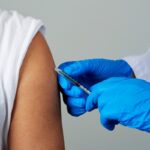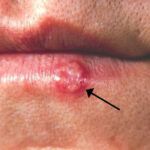A concerning new term, “razor blade throat,” has recently entered public discourse, describing an unusually severe and painful sore throat that some individuals are experiencing. This unsettling symptom has corresponded with the emergence and rapid spread of the NB.1.8.1 severe acute respiratory syndrome coronavirus 2 (SARS-CoV-2) variant.
This particular variant is currently responsible for the recent surge in COVID-19 cases in China and is now rapidly gaining traction in the United States. While the informal term “razor blade throat” vividly describes the intensity of the discomfort, it’s crucial to understand that it doesn’t necessarily indicate a fundamentally new type of COVID-19 infection. Instead, it serves as yet another stark reminder of the virus’s dynamic nature and the ongoing potential for a fresh Summer COVID-19 surge. Staying informed and vigilant about evolving symptoms and variants remains paramount for public health.
“Nimbus”: The Informal Name for NB.1.8.1
The scientific name for the variant, NB.1.8.1, can be quite a mouthful and challenging to remember. To address this, an informal new term has been gaining traction on social media: “Nimbus.” This catchy, memorable name, coined by T. Ryan Gregory, PhD, a professor of integrative biology at the University of Guelph in Ontario, Canada, in a late May tweet (or X post), offers a more accessible way for the public to refer to this specific SARS-CoV-2 lineage.
The Origin and Meaning of “Nimbus”
The word “nimbus” itself carries multiple connotations. While it might sound like a blend of “nimble” and “incubus,” its primary meaning is meteorological. In meteorology, a “nimbus” refers to a jagged type of storm cloud, often associated with rain or snow. This imagery could metaphorically represent the disruptive and unpredictable nature of a rapidly spreading viral variant.
Additionally, “nimbus” has a more divine definition, referring to the shining cloud or halo that traditionally surrounds a deity—be it mythological figures like Zeus and Athena, or even contemporary cultural icons like Taylor Swift, when they appear on Earth. This duality in meaning adds a layer of intrigue to the variant’s informal designation.
The Evolving Naming Convention of SARS-CoV-2 Variants
The process of naming SARS-CoV-2 variants and subvariants has been a complex and evolving journey over the past five years. Initially, a formal variant naming convention adopted progressively different Greek letters, beginning with Alpha, Beta, Delta, and so forth. This system provided a clear and standardized way to identify major variants of concern. However, this Greek odyssey of sorts did not continue indefinitely. Not long after the Omicron variants became dominant, the formal Greek naming schema was discontinued.
The default for newly emerging lineages transitioned to alphanumeric sequences devised by scientists meticulously tracking the genetics of the variants. These sequences, like NB.1.8.1 or LP.8.1, often resemble complex passwords or, as some humorously note, the names of Star Wars droids. This shift, while scientifically precise, lacked the public accessibility of the Greek letter system.
This motivated some individuals, like Dr. Gregory on social media, to spontaneously coin more memorable and evocative names for various new emerging variants, such as Arcturus, Kraken, Eris, and Pirola. These informal names often gain traction due to their ease of recall and descriptive power.
WHO Monitoring and Rapid U.S. Spread
The NB.1.8.1 variant has quickly captured the attention of global health authorities. On May 23, the World Health Organization (WHO) officially declared NB.1.8.1 as a “variant under monitoring.” This designation is based on several key factors: the specific mutations present in its spike proteins, which can influence transmissibility and immune evasion, and its fairly rapid spread in different parts of the world.
Its presence in the United States has escalated quickly. According to data from the CDC (Centers for Disease Control and Prevention), for the week ending on June 7, NB.1.8.1 was detected in approximately 37% of collected and tested samples from COVID-19 cases. This makes it the second most common SARS-CoV-2 variant in the U.S., trailing only LP.8.1 by a mere single percentage point.
However, it is crucial to interpret these numbers with caution, or as the article humorously puts it, “with a gigantic fanny pack of salt.” This caveat is necessary because a substantial percentage of COVID-19 cases in the U.S. currently go untested and unreported, meaning the true prevalence of NB.1.8.1 and other variants might be higher than official statistics indicate. This underscores the challenge of obtaining precise real-time epidemiological data in a less rigorously monitored environment.
“Razor Blade Throat”: A Very Sore Throat, Not Necessarily New
The term “razor blade throat” is an informal, colloquial description for a particularly severe sore throat. It’s important to distinguish this from a scientifically recognized, novel symptom.
The Limitations of Informal Reports
While the term “razor blade throat” has gained traction, primarily through informal reports on social media, it’s crucial to understand the limitations of such anecdotal evidence. Informal reports are not equivalent to peer-reviewed scientific studies or data from established clinical surveillance systems.
Social media platforms and the internet, while powerful for information dissemination, can sometimes create an echo chamber effect, making certain phenomena or symptoms appear more widespread or common than they truly are. A historical example often cited is the “Tide Pod challenge” several years ago; while it received significant media attention, it’s not as if a majority of people were actually ingesting laundry detergent. Similarly, it’s difficult to accurately gauge how common this so-called “razor blade throat” truly is without formal epidemiological data.
Furthermore, it is currently unclear what percentage of these “razor blade throats” are actually confirmed cases of COVID-19. Attributing every instance of severe pharyngitis solely to the NB.1.8.1 variant without proper testing would be a significant oversimplification.
Understanding Pharyngitis: Causes Beyond COVID-19
The medical term for inflammation of your pharynx is “pharyngitis.” The pharynx, commonly known as the throat, is a muscular tube situated behind your nasal cavity and mouth. It serves as the vital passageway for anything that you ingest, whether food or drink, before it travels down to your esophagus. Given its central role, the pharynx is susceptible to inflammation from a wide array of causes, not just viral infections like COVID-19.
Many different viruses can cause pharyngitis, including common cold viruses, influenza, mononucleosis, and even some herpes viruses. Various bacteria can also lead to a sore throat, with Streptococcus pyogenes (causing strep throat) being a well-known example. Beyond infections, allergies can trigger post-nasal drip, irritating the pharynx and causing soreness. Acid reflux, where stomach acid flows back up into the throat, is another common culprit, leading to a chronic sore throat and irritation. Even consuming foods that are particularly hot or spicy can temporarily inflame the pharyngeal lining.
In rarer, more serious cases, pharyngitis can even be a sign of a growth or tumor in the throat region. Interestingly, even something as simple as sleeping with your mouth open can lead to significant pharyngeal dryness, causing the mucus membranes to become irritated and result in a very sore throat upon waking. It is critically important to note that the degree of soreness—whether mild, moderate, or even “razor blade-like”—is not a reliable indicator of the underlying cause of the pharyngitis. A severe sore throat does not automatically mean COVID-19 or any specific, dangerous condition.
When to Seek Medical Attention
Given the wide range of potential causes for a sore throat, it is crucial to know when to seek professional medical advice. While a typical viral infection, like a common cold, should generally clear up well within a week, if your sore throat persists for longer than seven days, it is highly advisable to contact a qualified healthcare professional. This means consulting someone with genuine medical training, such as a doctor, rather than relying on unverified sources or individuals promoting unproven “magical treatments.”
A medical evaluation will be essential to rule out any potentially serious underlying conditions (the “uh-oh stuff”) and to ensure that any problems requiring specific treatment, such as a bacterial infection like strep throat, are appropriately addressed with antibiotics. Early diagnosis and intervention can prevent complications.
“Razor Blade Throat” and COVID-19: A Nuanced Perspective
While “razor blade throat” could certainly be a symptom of COVID-19, it’s important to view it within the broader context of known viral symptoms.
The Necessity of Testing for Diagnosis
Ultimately, it is impossible to definitively determine the cause of a very sore throat without a real medical exam and further testing. Therefore, one should never jump to conclusions or begin a sentence with, “I have a severe sore throat, therefore I must have [such and such].” The appropriate next step in a medical evaluation of a persistent or severe sore throat involves a healthcare professional checking for other accompanying symptoms and performing a thorough physical exam.
This examination should include visually inspecting your throat, tongue, and other related anatomical structures like your ears, as throat pain can sometimes be referred pain from ear issues. Such an evaluation might also entail swabbing the back of your throat to collect a sample, which can then be sent to a laboratory for testing for common pathogens like strep bacteria and SARS-CoV-2 (the virus that causes COVID-19). This laboratory confirmation is the only reliable way to pinpoint the exact cause of the infection.
In contemporary discourse, it’s common to hear individuals declare, “I’m pretty sure I don’t have COVID,” often without the necessary qualifying statement: “because I tested negative.” It’s imperative to reiterate that the only way to truly confirm or rule out an infection like COVID-19 is through proper testing. Furthermore, the rapid antigen tests commonly used for home COVID-19 testing have a very high false negative rate, especially if used too early in the infection, improperly, or if the viral load is low.
This means that a negative home test result does not necessarily mean you can definitively rule out a COVID-19 infection. The more accurate PCR tests performed at health clinics, which often involve the uncomfortable but effective cotton swab deep in the nasal cavity or back of the throat, provide a more reliable diagnosis.
Not a “New” Symptom, But a Reminder
It is important to understand that a sore throat has long been recognized as one of the possible symptoms of COVID-19. Its prevalence as a symptom became even more common with the emergence of the various Omicron variants. Therefore, a sore throat that feels intensely painful, like “razor blades,” would not represent an entirely “new” symptom of COVID-19.
Nor does its appearance necessarily indicate that the NB.1.8.1 variant is, on average, causing different or more severe outcomes compared to previous variants. The severity of a symptom can vary widely among individuals, regardless of the specific variant.
However, this doesn’t mean that the “NB” in NB.1.8.1 should stand for “no big deal.” COVID-19 continues to be a significant public health concern. The virus still has the potential to cause severe illness, leading to hospitalizations and, tragically, fatalities for a number of individuals. Moreover, a substantial portion of those infected can suffer from the debilitating, prolonged consequences of Long COVID, which can impact various organ systems and significantly diminish quality of life.
The fact that many politicians or public figures may no longer be actively discussing COVID-19 does not diminish its continued threat. As previously noted, there is evidence suggesting that the NB.1.8.1 variant may possess enhanced ability to bind to human cells, potentially making it more transmissible. The observed rapid spread of the NB.1.8.1 variant globally appears to support this possibility, reinforcing the need for ongoing vigilance.
It remains unclear precisely how many reported cases of “razor blade throat” are directly attributable to the new SARS-CoV-2 variant. However, it’s highly unlikely that anyone experiencing this symptom would find it desirable. Therefore, it is always better to be adequately prepared for the possibility of a severe sore throat and another potential Summer COVID-19 surge. The same evidence-based precautions that have proven effective throughout the pandemic remain relevant and available. These include:
- Wearing good quality face masks, such as N95 respirators, especially when in more crowded indoor areas where ventilation might be suboptimal.
- Ensuring good ventilation and air purification in indoor locations to reduce the concentration of airborne viral particles.
- Practicing frequent and thorough hand washing with soap and water or using an alcohol-based hand sanitizer to prevent surface transmission.
- Staying up to date on COVID-19 vaccination, taking into account that immune protection derived from the vaccine typically begins to wane at the four-to-six-month mark, necessitating boosters for continued optimal protection.
Maintaining a robust immune system through vaccination and adherence to these public health measures can help individuals avoid the sharp pains that may accompany a “razor blade throat” and navigate the ongoing challenges posed by evolving COVID-19 variants.








